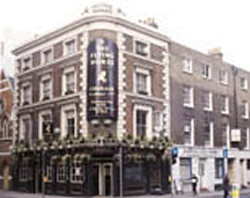List It!
How to get a Building Listed
Neil Burton
 |
| A row of late georgian house in Sun Street, Hackney, c1815-20, which the Georgian Group beliaves ought to be listed. The proposal was rejected on the grounds that the terrace, which includes the 'Flying Horse', is 'too altered'. |
Anyone can request the Government to list any building, but not all proposals are successful. Getting a building listed is partly a matter of getting the right information to the right person.
A 'listed building' is one which is included on
the statutory List of buildings of special architectural interest.
Buildings are added to the list as a result of surveys initiated
by the authorities or they may be 'spot listed' individually as
a result of a request usually made when there is a threat. Once
added to the list, a building is protected by law, and its demolition
or alteration without consent is a criminal offence.
The general criteria for including a building in
the statutory lists is fairly clear: in England and Wales all buildings
built before 1700 which survive in anything like their original
condition are normally eligible, as are most such examples of about
1700 to 1840. Progressively stricter selection requirements apply
to buildings erected after 1840. In Scotland all buildings erected
before 1840, 'the character of which remains substantially unimpaired'
are also included. No specific dates apply for listings in Northern
Ireland, but the draft Planning Policy Statement proposes similar
requirements for buildings constructed before the early 19th century.
Only 'selected' buildings after 1914 are normally listed and in
England the '30-year rule' means that anything built within the
last 30 years can only be considered if it is both at risk and of
such quality that it merits listing at Grade I or II*.
In the legislation the term 'building' is defined
quite broadly and can include boundary walls, fountains, sundials,
statues, bridges, bandstands and telephone boxes for example.
In all assessments age is obviously a major factor,
supplemented by 'importance' and 'rarity'. Both the latter are subjective
standards but there are some rules of thumb to follow. Importance
means both architectural and historic importance. If it is known
who designed it, the building can be measured against other works
by the same architect. Even if the architect is not known it may
be possible to show that a building is a good example of a particular
style; this may be particularly relevant if the style is characteristic
of a town or district. Architectural importance includes technology
and both materials and the method of construction may contribute
very much to a building's interest and special character. Historic
importance can consist in association with historical events or
figures or in being an early example of a particular type. Rarity
may be more difficult to establish although the computerised database
of listed buildings held at the Royal Commission on Historic Monuments
can be helpful on this point.
It is important to remember that in order to be
listed a building must be of intrinsic interest. Although many statutory
lists contain buildings shown to be listed 'mainly for group value',
contribution to the character of an area - as in a landmark building
like a church or a spire, for example - is not on its own sufficient
grounds for listing.
All suggestions for listing are channelled through
the appropriate Government department to the inspectors in the Listing
Branch at English Heritage, Cadw, Historic Scotland or the DoE Northern
Ireland. The inspectors will make an initial appraisal based on
the photographs and information supplied. Many buildings are rejected
at this stage. If the building seems a good candidate, the inspectors
will make a site inspection which may be followed by a recommendation
that the building be listed. All recommendations must be confirmed,
or not, by the relevant Secretary of State.
A proposal for listing should be supported by a
location map, a brief description of the building with the building
date (if known) and any other historical or architectural information
which makes the building special. The written material should be
supplemented by photographs of the building, both external elevations
and internal details if possible. Good clear photographs help enormously
because they form the basis of the initial sift. If the inspector
decides that the building is worth a site visit it will help him
or her to have a name and telephone number to contact for access.
Since most applications for spot listing are made
because of a particular threat to the building it is important to
spell out the nature of the threat and the timescale involved.
If a building has already been rejected for listing
in the past few years, the case will only be reconsidered if 'new
information' is provided.
Listing suggestions and supporting material should
be sent to the following addresses:
England
Listing Branch, Department for Culture Media and Sport,
2-4 Cockspur Street, London SW1Y 5DH
Northern Ireland
Department
of the Environment Northern Ireland, Environment and Heritage Service,
5/33 Hill Street, Belfast BT1 2LA
Scotland Listing Section, Historic Scotland, Longmore House, Salisbury
Place, Edinburgh EH9 1SH
Wales Designations Section, Cadw, Plas Carew, Unit 5/7, Cefn Coed, Parc Nantgarw CF15 7QQ



